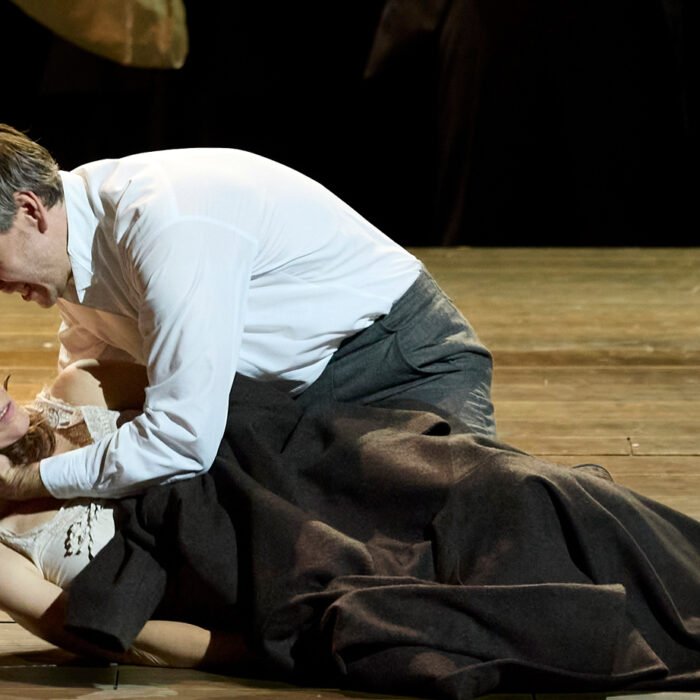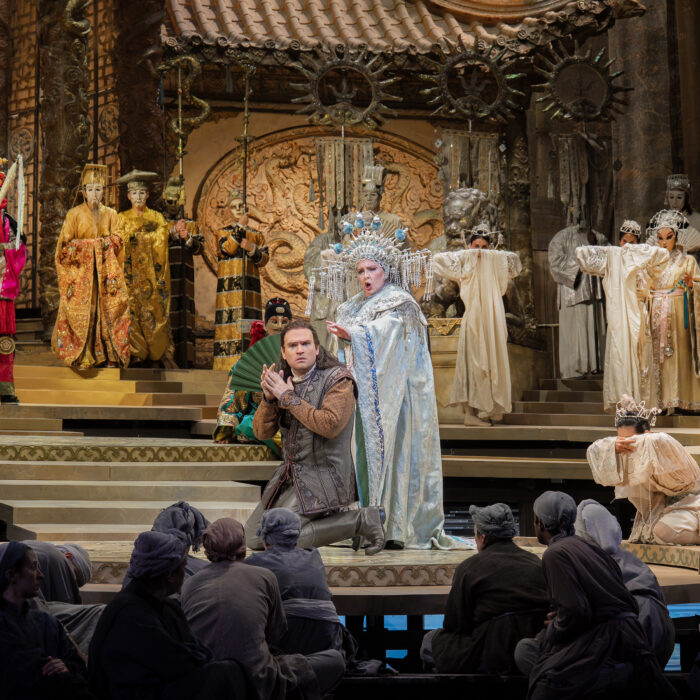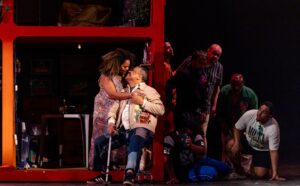
Theatro Municipal de São Paulo 2025 Review: Porgy and Bess
Latonia Moore & Juliana Taino Shine in Illuminating Production of Gershwin’s Beloved Opera
By Fabiana Crepaldi(Photo: Rafael Salvador)
On September 19th, the Theatro Municipal de São Paulo brought to the stage its first production of “Porgy and Bess,” an opera by George Gershwin (1898-1937), with a libretto by Edwin DuBose Heyward (1885-1940) and Ira Gershwin (1896-1983), based on the novel turned into a play “Porgy,” by DuBose Heyward. The theater assembled not only a cast made up of Black soloists, as specified by the composer, but also a creative team composed of Black Brazilians and led by stage director Grace Passô. One of the production’s biggest attractions, however, was the casting, especially Latonia Moore as Bess.
I attended the performance on the 21st, which coincided with the closing of the second edition of the “Abram alas” and the Forum of Women in Opera Latin America (OLA). Both events, which took place at the theater, aim to expand women’s space in the music industry and are held in partnership with the Fondazione Donne – Women in Music. This was good luck, because the final conference, open to the public, was by Conceição Evaristo, an important Black Brazilian writer.
Evaristo touched on a theme that always comes up when discussing “Porgy and Bess:” works that deal with Black people, but whose authors are white. Evaristo recognizes and values the importance of the many white writers who, throughout history, addressed themes related to Black people and helped them in their struggle to find a place in society. One of the names she mentioned was the (white) South African writer Nadine Gordimer, who fought against Apartheid and was persecuted. But Evaristo recalled a warning that Gordimer herself made in her book “The Essential Gesture:” no matter how much the white person suffers from the violence and prejudice of which Black people are victims, they will never experience it in their own body.
“Porgy and Bess” undoubtedly presents a stereotypical view of African Americans from the early 20th century. As Ellen Noonan pointed out in “The Strange Career of Porgy and Bess: Race, Culture, and America’s Most Famous Opera:” “’Porgy and Bess’ survived as a cherished example of Gershwin music, but no one described it as an authentic depiction of African American life any longer.”
On the other hand, in addition to having irresistible music, the work gave many Black singers the opportunity to start a career, especially in the mid-20th century. A notable example was the great Leontyne Price, whose career was boosted after she debuted as Bess in 1952, in the third revival of the opera.
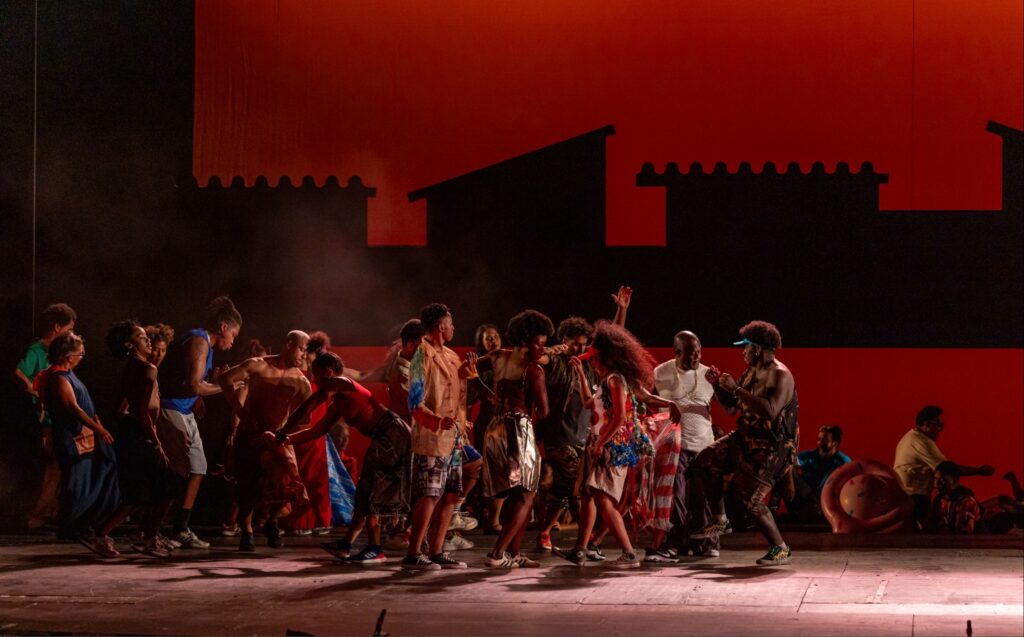
(Photo: Rafael Salvador)
Production Details
Grace Passô’s production brought the American story into the Brazilian reality, to the outskirts of São Paulo. However, Catfish Row remained an undefined place. Built from a design by Vinicius Cardoso, the beautiful and efficient set by visual artist Marcelino Melo is, basically, a large hollow clay brick and the shadows of houses in the background. The holes in the brick are the dwellings. This element so characteristic of Brazilian home construction became the house itself. In addition to the large brick, there were some miniature bricks (or rather, bricks in their actual size) hanging or scattered on the floor. It’s as if that large brick, or that set of dwellings, was one among many, and it had been zoomed in on. “Brick by brick in a magical design,” as in the song ‘Construção‘ by Chico Buarque, about the last day in the life of a worker who dies after falling from the top of a construction site.
In the visual field, another important highlight was the excellent lighting by Wagner Antonio. Red, white, and blue, the colors of the American flag, intentionally or coincidentally. The blue and red distinguished moments of calm from those of violence. When Crown killed Robbins, the stage darkened and the red light spots blinded our vision: a strong effect.
Alexandre Tavera‘s costumes had a naturalness of peripheral clothing, urban colors and fits, but without looking like the singers were wearing their own clothes from home. The costumes had patches, but without exaggeration, and even torn and mended, they didn’t lack charm. Mario Lopes‘s choreography followed the style of street dance, but very visceral at some moments. To cite an example, during the prayers and hymns due to Robbins’s death, the dancers exposed the suffering by writhing and thrashing about.
If there was one thing that bothered me, it was Achiles Luciano’s live videos. In addition to being a technique already used in two recent productions, the cameraman, crouching down to film Bess and Porgy in their second act duet, interfered with the scene and was distracting.
The theater chose to amplify the sound of the show. That is a controversial choice. We lost the naturalness of the sound and, mainly, its spatiality—the sound of each singer didn’t come from the spot where he or she was. On the other hand, the singers were freer to sing the jazz or spirituals without worrying about straining their voices. Fortunately, the amplification was not exaggerated and was well balanced.
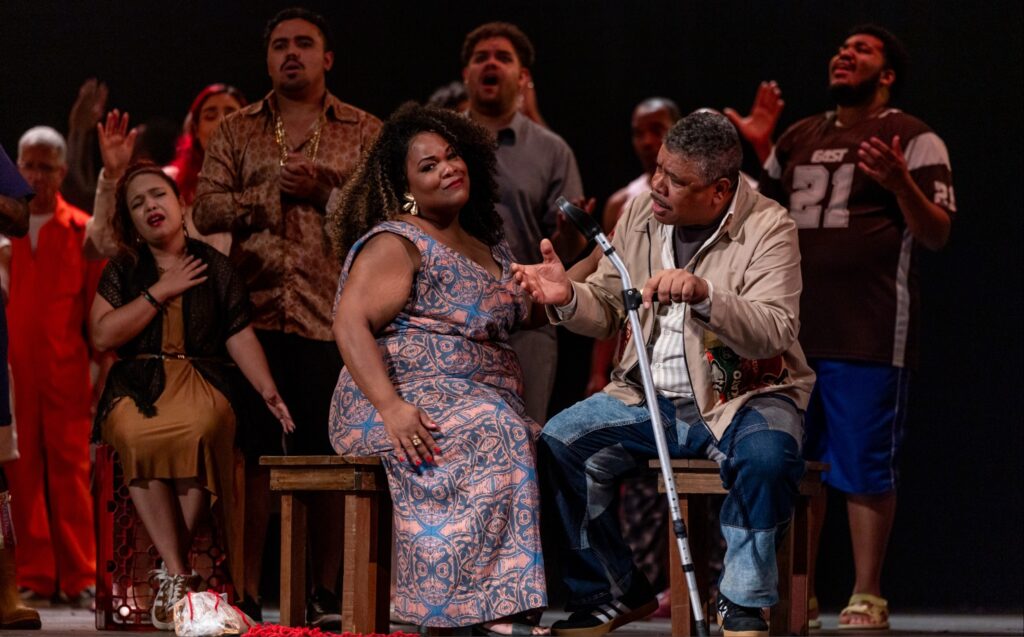
(Photo: Rafael Salvador)
Musical Highlights & Stunning Cast
Under the baton of Roberto Minczuk, the Municipal Symphony Orchestra did justice to Gershwin’s delightful music and ensured a dynamic and lively show. Pianist Leandro Roverso deserves special mention for his excellent performance in the introduction, displaying agility and irresistible jazziness. The chorus, formed by members of the Lyric and Paulistano choirs and prepared by Maíra Ferreira, performed convincingly and naturally.
The cast of singers was made up of Black artists, mostly Brazilians. And the result was, in general, very good, including the ensemble of the comprimarios. There are reports that the presence of Latonia Moore, generous and experienced in the repertoire, made all the difference during rehearsals.
As Jake, baritone Michel de Souza performed a contagious ‘A Woman Is a Sometime Thing.’ Tenor Jean William interpreted Sportin’ Life with ease and a brilliant voice, despite a certain mannerism and a somewhat open sound.
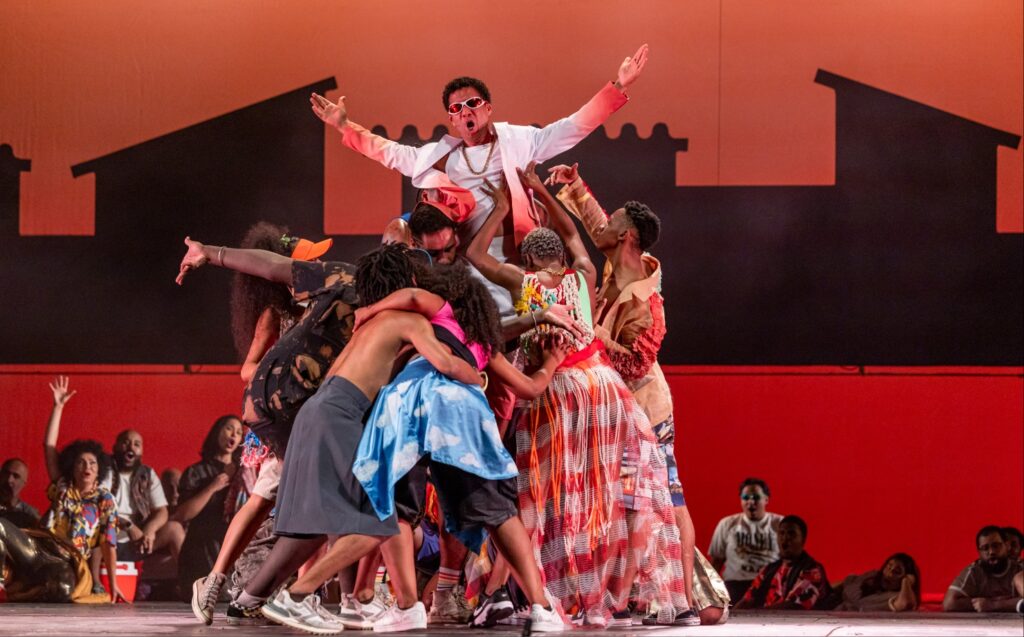
(Photo: Rafael Salvador)
In the role of Clara, the Colombian soprano Betty Garcés, with a voice rich in harmonics and with flavorful low notes, treated us to a ‘Summertime’ with well-executed nuances and portamenti. She’s a singer to watch. It had been a while since mezzo-soprano Edneia Oliveira appeared on São Paulo stages, and the result was a strong performance and singing that emphasized the parlando, which brought prominence to Maria.
Since South African baritone Bongani Justice Kubheka embodied an irresistible and vocally impeccable Escamillo in “Carmen” last year, he has become a favorite of the audience and the theater. Just this year, he’s come twice: in March, he was Gonzáles in “Il Guarany,” and now, Crown in “Porgy and Bess.” With a warm and powerful voice, Kubheka portrayed a firm and self-assured Crown. I’d love to see him in some Verdi work—”Il Trovatore,” “Un Ballo in Maschera”…
After ‘Summertime, My Man’s Gone Now,’ Serena’s lament, is undoubtedly the most anticipated tune by the audience; and it’s the most impressive aria in the score. In São Paulo, the Serena of mezzo-soprano Juliana Taino shone and was duly applauded. Secure and homogeneous, Taino’s voice went from a brilliant high note to a sonorous and sustained low register. Taino concluded the aria with an intense ‘Since my man is dead!’ (both in the low and in the high registers). In fact, Taino’s voice imposed itself from her entrance, ‘Honey boy!’, and the artist maintained the high level throughout the night, especially in her prayer ‘Oh, Doctor Jesus.’ In the theater’s next season, Taino is cast to play Eboli in “Don Carlo.” Her performance in “Porgy and Bess” only increased expectations.
Porgy received a secure interpretation from Luiz-Ottavio Faria, a Brazilian bass who lives in the United States. Faria embodied a docile and captivating Porgy; his song ‘Oh, I Got Plenty o’ Nuttin’’ was one of the evening’s highlights. However, a certain tiredness in the bass’ voice was noticeable, as he was performing for the third consecutive day. Despite there being two casts that alternate, Faria sings in both.
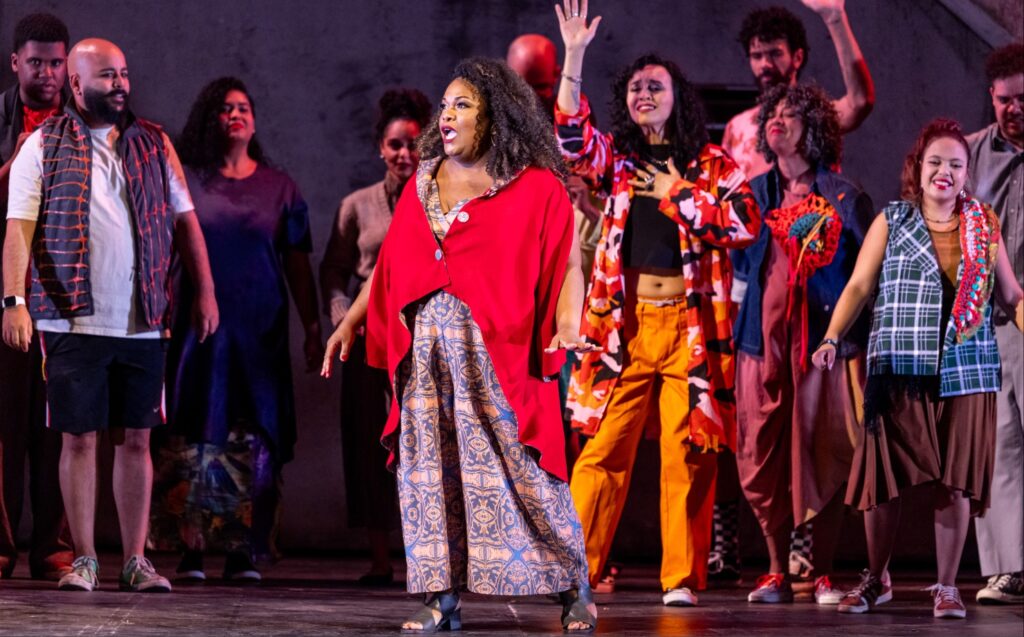
(Photo: Rafael Salvador)
Latonia Moore as Bess
It’s hard to count how many times Latonia Moore has been Serena. It was in that role that I saw her stop the show in 2019 at the Metropolitan Opera. It’s easy, however, to say how many times she has interpreted Bess. It was only once, in concert, in 2012, with the Berlin Philharmonic under Simon Rattle’s baton. The São Paulo production was, therefore, more than a return to a role from thirteen years ago, but Moore’s debut as Bess in a staged production.
In a beautiful interview given to João Luiz Sampaio, one of the most qualified Brazilian journalists specializing in opera, and published on the Concerto website, Moore comments on the fact that she had never sung Bess on stage. “Do you know why I had never been hired to sing Bess? Because people had a problem with an overweight singer singing a sick, addicted character. If I’m here, it’s because the Municipal has a casting manager, Pedro Guida, who knew how to look at me with his ears and imagined me in the role. It’s a reality in our career to feel forced to occupy spaces based on prejudices.”
She touched on a crucial point when she said that the theater’s casting director knew how to look at her with his ears and imagine her as Bess. More complex than setting aside stereotypes and prejudices is imagining how a singer’s voice will respond. And the bet that her heavier voice, capable of producing such an impactful Serena, would serve Bess well, was successful.
There’s another important point in this transition from Serena to Bess: Serena has the aria ‘My Man’s Gone Now,’ with which Moore conquered the Met (and Juliana Taino, the Municipal de São Paulo). Bess, however, has no aria. Sampaio pointed out this fact, to which Moore responded: “It’s interesting that you mention the aria because Bess’s case is curious, as she has no aria. When she sings ‘Summertime,’ the aria has already been sung by Clara and has reappeared two more times throughout the score.” For Moore, Bess’s fascination is dramatic: “Bess is always depending on the will of the other characters. You have to dive deep, invest a lot in acting, to find her, her will, her desire. That’s a huge and fascinating challenge.”
Latonia Moore has an incredible stage presence; the scene seemed to revolve around her. I confess that, with her performance, I discovered the true protagonism of Bess. It wasn’t for nothing that, in the transition from the novel (“Porgy”) to the opera, Bess also became a title role. She has no aria, but she is a guiding thread in the plot; she’s psychologically the most complex character.
Moore’s command of her voice is impressive. The malleability of her voice stands out, as in “For Gawd’s sake, give me a touch of happy dust. / I shakin’ so I can hardly stand,” a phrase that ends with a filato that blends with the woodwinds. Her register changes occur easily, naturally; the color of her voice shifts from a woody low to a limpid high according to the meaning and intention of the phrases. Moore also makes a perfect transition between speech and song, as in ‘See what I gets for you./ Yo’ woman is easy when you know the way.’
If Bess has no aria, she has memorable duets. Two of them are with Porgy. In the first, ‘Bess, You Is My Woman Now,’ Moore’s and Faria’s voices combined perfectly. It was a moment of profound beauty and delicacy: I can still hear Moore’s voice “sliding” into the high and her perfect legato.
Another special moment was the duet between Bess and Crown, in the second scene of the second act. This duet starts somewhat spoken, recited, with Bess uncomfortable with the reunion, and ends with a jazz song that Moore interpreted with irreproachable style.
The great advantage of having Moore as Bess is that the character has a protagonism in the third act that goes beyond the repetition of ‘Summertime’ (which was very beautiful!). When the third act arrives, two hours of opera have already passed, and with them, the main spirituals, arias, and jazz songs. Although not long, it’s an act that depends a lot on the singers’ acting to not become tiring. Moore made all the difference for much of the Sunday audience (including myself) to leave the theater saying they didn’t feel the time pass.
I’ve learned that negotiations are well advanced for Latonia Moore to return to São Paulo next year to make her debut as Maddalena in “Andrea Chénier”. In addition to “Chénier,” other highlights of the exciting 2026 season at the Municipal de São Paulo are “Don Carlo” (with five acts, Atalla Ayan in the title role and Ailyn Perez alternating with the great Brazilian soprano Ludmilla Bauerfeldt as Elisabetta) and “Tristan und Isolde,” starring Simon O’Neill and Annemarie Kremer.
The current season will still have two titles. The next one will be “Macbeth,” with Marigona Qerkezi and Olga Maslova alternating as Lady and Craig Colclough in the title role. Closing the season, the same production of “Les Indes Galantes,” under the baton of Leonardo García-Alarcón, that toured Europe. It’s thanks to the effort and persistence of Andrea Caruso, the dynamic director of the theater, that this last title will come to São Paulo.
With this delightful “Porgy and Bess” and the good prospects for the upcoming titles, the reader must be supposing that we have a lot to celebrate in São Paulo. Not quite. As it is currently fashionable around the world and has never gone out of fashion here, political disputes threaten to bring down the theater’s administration and, as always happens, with it, the next season. But yes, I still have hope that this work that took the theater out of its isolation and put it in contact with the world of opera will continue.

